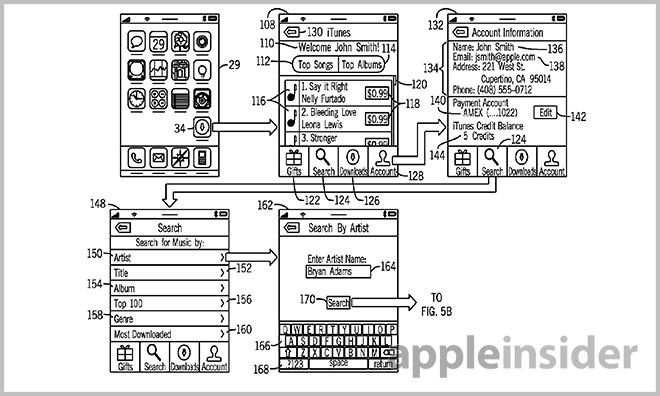The U.S. Patent and Trademark Office on Thursday published an Apple patent application for a system that allows users to "gift" media content from iTunes and their own library to other iOS device owners, with the transaction facilitated by near-field communication.

Source: USPTO
The lengthy patent filing, titled "Media gifting devices and methods," is a fairly straightforward invention that could may have greater implications as to how iOS device users purchase and consume digital content.
At the heart of the invention is gifting, or the simple idea of purchasing a song, e-book or video to give to another person. The document describes two main modes of giving gifts: purchasing media directly from the iTunes store, or sending a copy of already owned media to another device.
Apple already has systems in place for gifting digital media with the iTunes store app, while Passbook-redeemable gift cards can be purchased with the Apple Store app.
Currently, there is no way to gift a piece of owned media directly from one device to another through iTunes.
Thursday's patent application outlines a number of techniques that iOS device owners can use to give gifts provided by iTunes, all of which involve digital rights management (DRM) and authentication keys. The system is similar to Apple's established giving methods in that one user purchases a gift and sends it to another person, but instead of using email, a gifter can transfer the purchase to the giftee over NFC.
NFC transfer.
The first step of a transaction originating from the iTunes Store occurs when the gifter selects an item they want to give away, such as a song. In one embodiment, the next step authorizes a gift charge to be placed on the gifter's iTunes account, which the recipient will redeem for the associated file.
Downloads in this scenario are handled by the iTunes server, which checks the recipient's authorization key before pushing out a gift. In some cases, the download will begin automatically, though the invention allows for recipients to retrieve the file at a later time.
Redeeming the gift.
The second, and arguably more interesting, of the two scenarios is the gifting of an already owned media file.
Here, Apple again employs a method of authentication via a central server to determine what can and can't be downloaded by a recipient device. For example, a gifter can send a copy of a song currently playing on their device by tapping a user interface button. The operations performed after the gift purchase fork into two separate actions.
In one instance, the gifter's device sends a request to the server for a charge to be placed on their account for a given song. The giftee transfers an authentication notification to the recipient's phone, which then has permission to download the song from iTunes.
Alternatively, if Internet access is unavailable, the gifter can send a locked version of the media file via NFC to a giftee's device, along with a DRM or authentication code to be redeemed when network access is reestablished. Both devices will communicate with the server, and the purchase will be deducted from the gifter's account, while the recipient will have the media file unlocked. Another option when offline is to send just the key without the associated file, which can later be used to download the song.
Flowchart showing gifting of owned media.
Also noted are various operations to ensure proper transmission of authorization and DRM keys, including checks with a central server for both gifter and giftee, purchase acceptance codes sent via NFC, and other safeguards.
Finally, the patent filing adds that a number of attachments, such as photos and audio messages, can be sent along with the gift.
It is unknown if Apple will roll out a gifting feature in a subsequent version of iOS, but the service could be a boon for iTunes and content providers as users would have yet another well-implemented media purchasing system to choose from.
Apple's media gifting patent application was first filed for in 2013 and credits Gloria Lin, Amir Mahood Mikhak, Taido Lantz Nakajima, Sean Anthony Mayo, Michael Rosenblatt and Andrew Hodge as its inventors.


